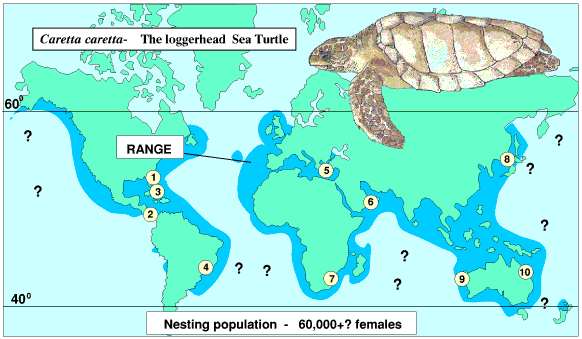Loggerhead Sea Turtle
Cole Martiniak
Background of Loggerheads
The Loggerhead Sea Turtle is a medium sized reptile found in coastal bays and estuaries along the Atlantic, Pacific, and Indian Oceans, with the majority of them found along the Eastern coastline of the US. They grow up to be around 3.5 feet, weigh up to 375 pounds, and can live up to 50 years in the wild. They got their name due to their unusually large heads and strong jawbones. The Loggerhead Sea Turtle is a carnivore that feeds mostly upon shellfish, such as horseshoe crabs, clams, mussels, and other invertebrates. Their powerful jaws make it easy for them to crush and devour their prey. Their carapace, also known as their shell, is reddish-brown and shaped like a heart. This species nests on beaches and lays its eggs at night. Their nesting season goes from April to September and they are known for laying more than 100 eggs at one time! It is estimated that there are around 40,000-50,000 nesting females alive today.
Listing Date and Type of Listing
The Loggerhead Sea Turtle was first added to the endangered species list July 28, 1978. However, in September 2011 the species was broken up into 9 distinct regions, with four of the nine being listed as threatened and the other five being endangered. In the US they are listed as threatened and internationally they are endangered.
Cause of Listing and Main Threats
 |
| A Loggerhead trapped in a net. Photo by Alejandro Fallabrino |
Description of Recovery Plan
The recovery plan has many parts, thus ensuring the safety of the Loggerhead Sea turtles future. The main part of the plan is to protect and manage the nesting habitats of the Loggerhead. The recovery team wants to make sure the number of nests in each subunit is increasing and hope that that would correspond to an increase in nesting females. Next, is that they want to increase the abundance of juveniles in the oceans and also increase the rate at which they are being sent out into the ocean. Third, is to facilitate sufficient feeding, migratory, and internesting marine habitats to protect growth and reproduction. Lastly, along with prohibiting harvest, their plan is to minimize all human interference, such as vessel strikes, marine debris ingestion, and bycatch in domestic and international fisheries. It would be a shame to lose such a majestic creature, especially if we are the ones sending this species to the grave.
Find ways to help Loggerhead Sea Turtles here
For more info click here
Sources
1. http://www.fws.gov/northflorida/seaturtles/turtle%20factsheets/loggerhead-sea-turtle.htm
Find ways to help Loggerhead Sea Turtles here
For more info click here
Sources
1. http://www.fws.gov/northflorida/seaturtles/turtle%20factsheets/loggerhead-sea-turtle.htm
_2.jpg)


No comments:
Post a Comment